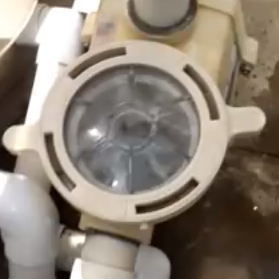Suction Side Air Leaks
A suction side air leak is most commonly indicated by air under the pump lid. In the case of a really bad suction air leak you will see a lot of air and the water will be splashing around under the pump lid. Or the pump wont even be able to suck water, only air. In a minor case you will just see a tiny stream air bubbles under the pump lid. And in some instances you will see air bubbles come back to the pool through the return jets. In either of these cases the pump is basically being starved for water and this can cause many other problems such as the pump over heating and it needs to be fixed.

There is only one place air leaks can happen: on the suction side of the plumbing. Air leaks can only occur before the water gets to the pump impeller. This can be anywhere from the pump (including the housing) to the skimmer, all PVC connections, joints, and valves are suspect. It can not be located after the pump, in this case you will be leaking water out not sucking air in. In rare cases a suction leak can be the cause of an underground suction pipe that has been punctured, or cracked. But don’t worry, this is very rare. If you recently had someone digging in your yard, or a large heavy vehicle driving over buried plumbing lines this may be the cause but it is very rare, so check all the easy stuff first.
So, how do you fix a suction air leak? Well, the first thing you have to do is find the suction leak. Then all you have to do is seal it up so that air can not be sucked into the piping. Finding the source of the suction leak can be a bigger job then actually fixing it. Here is a list of places you should look first, we put them in the order from most common to least common:
1. Pool water level. If the water level in the pool is low the pump can create enough suction at the skimmer to vortex the water and suck air down the line to the pump. If it is vortexing, you can usually hear it sucking air at the skimmer. If this is the case, you need to raise the level of water in the pool. In general the water should be half way up the skimmer. If your skimmer throat has a weir or flap door in it, check that it moves freely and does not get stuck in the UP position. If the weir is getting stuck in the UP position then the pump will drain the skimmer and start to suck air.
2. Pump lid o-ring on the pump basket lid. The lid o-ring on the pump must completely seal the lid to the pump housing. In many cases the lid o-ring needs to be replaced or simply just needs some lubricant. Only use a Silicon or Teflon based lubricant such as magic lube, do not use petroleum or WD-40.
3. Pump housing drain plugs. The small o-rings on the drain plug can becomes cracked and brittle and start to allow air to be sucked into the housing. You can replace the o-ring and apply a bit of silicone sealant to help seal it up.
4. Male adapter threaded into the front of the pump. This is pretty common, we see a suction leak in the PVC at the PVC male adapter that is threaded into the front of the pump housing. This is only the case if your pump does not use unions to connect the housing to the PVC pipe. Many installers use a standard SCH40 PVC male adapter. This can cause problems over time because if the pump ever over heats, this fitting will get hot and when it cools it will shrink slightly enough to let air be sucked in. If you suspect this is the case, the best solution is to cut out the male adapter and install a threaded pump union. If you dont have enough room in the plumbing to install a pump union, a CPVC nipple should be used. CPVC has a higher heat rating and will not give you any problems over time.
4. PVC plumbing joints. Any PVC the looks sloppy, crooked, or bent should be suspect. Poorly glued PVC joints can cause air to be sucked in. The only fix is to cut out the old PVC joints and redo them.
5. 3-Way valves, Check valves, Ball valves. Any valve on the suction side could be a culprit. They may need new housing o-rings, stem o-rings, or just replaced. You can sometimes put your year up to one that is sucking air and hear it sucking the air in.
6. Broken underground pipes. This is very rare, so check all the above first before even considering this as an option. If you think this is possible, its outside the scope of this article so i would suggest calling a Leak Detection service that can pressurize the suction lines and try to identify the place to start digging.
Inspect each of the above. 99% of the times its something very simple. Good advice is not to waste your time looking around the filter or other equipment, where an air leak can not be produced. Remember it is some place between the pump and the pool.


